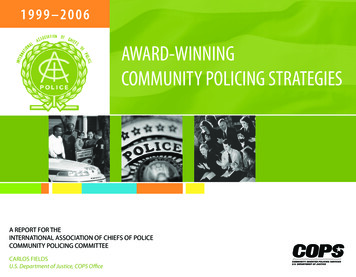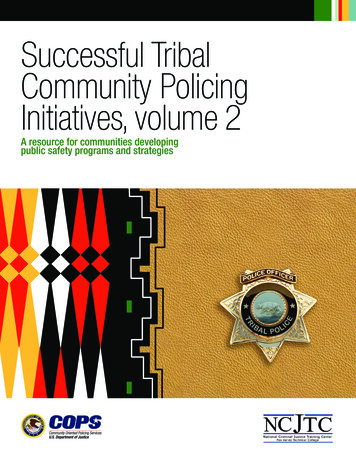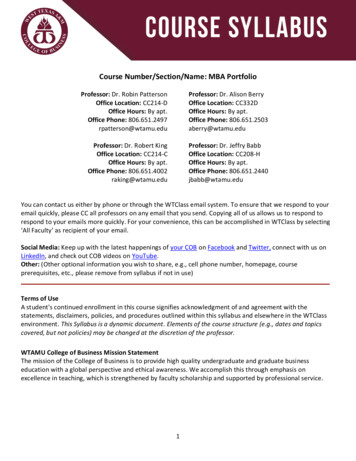
Transcription
Community PolicingDefined
The Primary Elements of Community PolicingNonprofits / Service ProvidersUsing the Crime Triangle
Community Policing DefinedCommunity policing is a philosophy that promotes organizational strategies that supportthe systematic use of partnerships and problem-solving techniques to proactively addressthe immediate conditions that give rise to public safety issues such as crime, social disorder,and fear of crime.Community policingcomprises threekey components:Community PartnershipsCollaborative partnerships between the law enforcement agency and theindividuals and organizations they serve to develop solutions to problems andincrease trust in policeOrganizational TransformationThe alignment of organizational management, structure, personnel, andinformation systems to support community partnerships and proactiveproblem solvingProblem SolvingThe process of engaging in the proactive andsystematic examination of identified problemsto develop and evaluateeffective responses1
CommunityPartnershipsCollaborative partnerships between the law enforcement agency and the2individuals and organizations they serve to develop solutions to problemsand increase trust in policeCommunity policing, recognizing that police rarely can solve publicsafety problems alone, encourages interactive partnerships with relevantstakeholders. The range of potential partners is large, and these partnershipscan be used to accomplish the two interrelated goals of developing solutionsto problems through collaborative problem solving and improving public trust.The public should play a role in prioritizing and addressing publicsafety problems.Other Government AgenciesLaw enforcement organizations can partner with a number of othergovernment agencies to identify community concerns and offer alternativesolutions. Examples of agencies include legislative bodies, prosecutors,probation and parole, public works departments, neighboring law enforcementagencies, health and human services, child support services, ordinanceenforcement, and schools.
Individuals who live, work, or otherwise have an interest in the community—volunteers, activists, formal and informal community leaders, residents,visitors and tourists, and commuters—are a valuable resource for identifyingcommunity concerns. These factions of the community can be engaged inCommunity Policing DefinedCommunity Members/Groupsachieving specific goals at town hall meetings, neighborhood associationmeetings, decentralized offices/storefronts in the community, and team beatassignments.Nonprofits / Service ProvidersAdvocacy and community-based organizations that provide services to thecommunity and advocate on its behalf can be powerful partners. These groupsoften work with or are composed of individuals who share common interestsand can include such entities as victims groups, service clubs, support groups,issue groups, advocacy groups, community development corporations, and thefaith community.Private BusinessesFor-profit businesses also have a great stake in the health of the communityand can be key partners because they often bring considerable resourcesto bear in addressing problems of mutual concern. Businesses can helpidentify problems and provide resources for responses, often including theirown security technology and community outreach. The local chamber ofcommerce and visitor centers can also assist in disseminating informationabout police and business partnerships and initiatives, and crime preventionpractices.MediaThe media represent a powerful mechanism by which to communicate withthe community. They can assist with publicizing community concerns andavailable solutions, such as services from government or community agenciesor new laws or codes that will be enforced. In addition, the media can have asignificant impact on public perceptions of the police, crime problems, andfear of crime.3
4OrganizationalTransformationThe alignment of organizational management, structure, personnel, andinformation systems to support community partnerships and proactiveproblem solvingThe community policing philosophy focuses on the way that departmentsare organized and managed and how the infrastructure can be changed tosupport the philosophical shift behind community policing. It encouragesthe application of modern management practices to increase efficiency andeffectiveness. Community policing emphasizes changes in organizationalstructures to institutionalize its adoption and infuse it throughout the entiredepartment, including the way it is managed and organized, its personnel, andits technology.
Under the community policing model, police management infuses communitypolicing ideals throughout the agency by making a number of critical changesin climate and culture, leadership, formal labor relations, decentralizeddecision making and accountability, strategic planning, policing andCommunity Policing DefinedAgency Managementprocedures, organizational evaluations, and increased transparency.Climate and cultureChanging the climate and culture means supporting a proactiveorientation that values systematic problem solving and partnerships.Formal organizational changes should support the informal networks andcommunication that take place within agencies to support this orientation.LeadershipLeaders serve as role models for taking risks and building collaborativerelationships to implement community policing, and they use their positionto influence and educate others about it. Leaders, therefore, must constantlyemphasize and reinforce community policing’s vision, values, and missionwithin their organization and support and articulate a commitment tocommunity policing as the predominant way of doing business.Labor relationsIf community policing is going to be effective, police unions and similar formsof organized labor must be a part of the process and function as partners inthe adoption of the community policing philosophy. Including labor groupsin agency changes can ensure support for the changes that are imperative tocommunity policing implementation.Decision makingCommunity policing calls for decentralization in both command structureand decision making. Decentralized decision making allows frontline officersto take responsibility for their role in community policing. When an officeris able to create solutions to problems and take risks, he or she ultimatelyfeels accountable for those solutions and assumes a greater responsibility forthe well-being of the community. Decentralized decision making involvesflattening the hierarchy of the agency, increasing tolerance for risk taking in5
problem-solving efforts, and allowing officers discretion in handling calls. Inaddition, providing sufficient authority to coordinate various resources toattack a problem and allowing officers the autonomy to establish relationshipswith the community will help define problems and develop possible solutions.Strategic planningThe department should have a written statement reflecting a departmentwide commitment to community policing and a plan that matches operationalneeds to available resources and expertise. If a strategic plan is to have value,the members of the organization should be well-versed in it and be ableto give examples of their efforts that support the plan. Components suchas the organization’s mission and values statement should be simple andcommunicated widely.PoliciesCommunity policing affects the nature and development of departmentpolicies and procedures to ensure that community policing principles and6practices have an effect on activities on the street. Problem solving andpartnerships, therefore, should become institutionalized in policies, along withcorresponding sets of procedures, where appropriate.Organizational evaluationsIn addition to the typical measures of police performance (arrests,response times, tickets issued, and crime rates), community policing callsfor broadening police outcome measures to include such things as greatercommunity satisfaction, less fear of crime, the alleviation of problems,and improvement in quality of life. Community policing calls for a moresophisticated approach to evaluation—one that looks at not only howoutcomes are measured but also how feedback information is used.TransparencyCommunity policing involves decision-making processes that are moreopen than traditional policing. If the community is to be a full partner, thedepartment needs mechanisms for readily sharing relevant information oncrime and social disorder problems and police operations with the community.
It is important that the organizational structure of the agency ensure thatlocal patrol officers have decision-making authority and are accountablefor their actions. This can be achieved through long-term assignments,the development of officers who are generalists, and using special unitsCommunity Policing DefinedOrganizational Structureappropriately.Geographic assignment of officersWith community policing, there is a shift to the long-term assignment ofofficers to specific neighborhoods or areas. Geographic deployment plans canhelp enhance customer service and facilitate more contact between police andcitizens, thus establishing a strong relationship and mutual accountability.Beat boundaries should correspond to neighborhood boundaries, and othergovernment services should recognize these boundaries when coordinatinggovernment public-service activities.DespecializationTo achieve community policing goals, officers have to be able to handlemultiple responsibilities and take a team approach to collaborative problemsolving and partnering with the community. Community policing encouragesits adoption agency-wide, not just by special units, although there may be aneed for some specialist units that are tasked with identifying and solvingparticularly complex problems or managing complex partnerships.Resources and financesAgencies have to devote the necessary human and financial resources tosupport community policing to ensure that problem-solving efforts are robustand that partnerships are sustained and effective.PersonnelThe principles of community policing need to be infused throughout theentire personnel system of an agency, including recruitment, hiring, selection,and retention of all law enforcement agency staff, from sworn officers tocivilians and volunteers. Personnel evaluations, supervision, and training mustalso be aligned with the agencies’ community policing views.7
Recruitment, hiring, and selectionAgencies need a systematic means of incorporating community policingelements into their recruitment, selection, and hiring processes. Jobdescriptions should recognize community policing and problem-solvingresponsibilities and encourage the recruitment of officers who have a “spirit ofservice” instead of only a “spirit of adventure.” A community policing agencyalso has to thoughtfully examine where it is seeking recruits, whom it isrecruiting and hiring, and what is being tested. Agencies are also encouragedto seek community involvement in this process through the identification ofcompetencies and participation in review boards.Personnel supervision/evaluationsSupervisors must tie performance evaluations to community policingprinciples and activities that are incorporated into job descriptions.Performance, reward, and promotional procedures should support soundproblem-solving activities, proactive policing, community collaboration, andcitizen satisfaction with police services.8TrainingTraining at all levels—academy, field, and in-service—must supportcommunity policing principles and tactics. It also needs to encourage creativethinking, a proactive orientation, communication and analytical skills, andtechniques for dealing with quality-of-life concerns and maintaining order.Officers can be trained to identify and correct conditions that could lead tocrime, raise public awareness, and engage the community in finding solutionsto problems. Field training officers and supervisors need to learn how toencourage problem solving and help officers learn from other problem-solvinginitiatives. Until community policing is institutionalized in the organization,training in its fundamental principles will need to take place regularly.Information Systems (Technology)Community policing is information-intensive, and technology plays a centralrole in helping to provide ready access to quality information. Accurate andtimely information makes problem-solving efforts more effective and ensuresthat officers are informed about the crime and community conditions of
improving two-way communication with citizens and in developing agencyaccountability systems and performance outcome measures.Communication / access to dataCommunity Policing Definedtheir beat. In addition, technological enhancements can greatly assist withTechnology provides agencies with an important forum by which tocommunicate externally with the public and internally with their own staff.To communicate with the public, community policing encourages agencies todevelop two-way communication systems through the Internet that allow foronline reports, reverse 911 and e-mail alerts, discussion forums, and feedbackon interactive applications (e.g., surveys or maps), thereby creating ongoingdialogues and increasing transparency.Technology encourages effective internal communication throughmemoranda, reports, newsletters, e-mail and enhanced incident reporting,dispatch functions, and communications interoperability with other entitiesfor more efficient operations. Community policing also encourages the use oftechnology to develop accountability and performance measurement systemsthat are timely and contain accurate metrics and a broad array of measuresand information.Community policing encourages the use of technology to provide officers withready access to timely information on crime and community characteristicswithin their beats, either through laptop computers in their patrol cars orthrough personal data devices. In addition, technology can support crime/problem analysis functions by enabling agencies to gather more detailedinformation about offenders, victims, crime locations, and quality-of-lifeconcerns and to further enhance analysis.Quality and accuracy of dataInformation is only as good as its source; therefore, it is not useful if it isof questionable quality and accuracy. Community policing encouragesagencies to put safeguards in place to ensure that information from varioussources is collected in a systematic fashion and entered into central systemsthat are linked to one another and checked for accuracy so that it can beused effectively for strategic planning, problem solving, and performancemeasurement.9
ProblemSolvingThe process of engaging in the proactive and systematic examinationof identified problems to develop and evaluate effective responsesCommunity policing emphasizes proactive problem solving in a systematicand routine fashion. Rather than responding to crime only after it occurs,community policing encourages agencies to proactively develop solutions tothe immediate underlying conditions contributing to public safety problems.Problem solving must be infused into all police operations and guide decisionmaking efforts. Agencies are encouraged to think innovatively about theirresponses and view making arrests as only one of a wide array of potentialresponses. A major conceptual vehicle for helping officers to think aboutproblem solving in a structured and disciplined way is the SARA (scanning,analysis, response, and assessment) problem-solving model.10
The objectives of scanning are to identify a basic problem, determine thenature of that problem, determine the scope of seriousness of the problem,and establish baseline measures. An inclusive list of stakeholders for theselected problem is typically identified in this phase. A problem can beCommunity Policing DefinedScanning: Identifying and prioritizing problemsthought of as two or more incidents similar in one or more ways and that is ofconcern to the police and the community. Problems can be a type of behavior,a place, a person or persons, a special event or time, or a combination of anyof these. The police, with input from the community, should identify andprioritize concerns.Analysis: Researching what is known about the problemAnalysis is the heart of the problem-solving process. The objectives of analysisare to develop an understanding of the dynamics of the problem, develop anunderstanding of the limits of current responses, establish correlation, anddevelop an understanding of cause and effect. As part of the analysis phase,it is important to find out as much as possible about each aspect of the crimetriangle by asking who, what, when, where, how, why, and why not about thevictim, offender, and crime location.Response: Developing solutions to bring about lasting reductionsin the number and extent of problemsThe response phase of the SARA model involves developing andimplementing strategies to address an identified problem by searching forstrategic responses that are both broad and uninhibited. The response shouldfollow logically from the knowledge learned during the analysis and shouldbe tailored to the specific problem. The goals of the response can range fromeither totally eliminating the problem, substantially reducing the problem,reducing the amount of harm caused by the problem, or improving the qualityof community cohesion.Assessment: Evaluating the success of the responsesAssessment attempts to determine if the response strategies were successfulby understanding if the problem declined and if the response contributedto the decline. This information not only assists the current effort but alsogathers data that build knowledge for the future. Strategies and programs can11
be assessed for process, outcomes, or both. If the responses implemented arenot effective, the information gathered during analysis should be reviewed.New information may have to be collected before new solutions can bedeveloped and tested. The entire process should be viewed as circular ratherthan linear, meaning that additional scanning, analysis, or responses maybe required.Using the Crime Triangle to Focus on Immediate Conditions(Victim/Offender/Location)To understand a problem, many problem solvers have found it useful tovisualize links among the victim, offender, and location (the crime triangle)and those factors that could have an impact on them: for example, capableguardians for victims (e.g., security guards, teachers, and neighbors), handlersfor offenders (e.g., parents, friends, and probation officers), and managers forlocations (e.g., business merchants, park employees, and motel clerks). Ratherthan focusing primarily on addressing the root causes of a problem, the policefocus on the factors that are within their reach, such as limiting criminal12opportunities and access to victims, increasing guardianship, and associatingrisk with unwanted behavior.John E. Eck, “Police Problems: The Complexity of Problem Theory, Research and Evaluation,”in Problem-Oriented Policing: From Innovation to Mainstream, ed. Johannes Knutsson, vol. 15of Crime Prevention Studies (Monsey, NY: Criminal Justice Press, 2003), 79–114.
About the COPS OfficeThe Office of Community Oriented Policing Services (COPS Office) is the component of theU.S. Department of Justice responsible for advancing the practice of community policing bythe nation’s state, local, territory, and tribal law enforcement agencies through informationand grant resources.Rather than simply responding to crimes once they have been committed, communitypolicing concentrates on preventing crime and eliminating the atmosphere of fear it creates.Earning the trust of the community and making those individuals stakeholders in their ownsafety enables law enforcement to better understand and address both the needs of thecommunity and the factors that contribute to crime.COPS Office resources, covering a wide breadth of community policing topics—from schooland campus safety to gang violence—are available, at no cost, through its online ResourceCenter at www.cops.usdoj.gov. This easy-to-navigate website is also the grant applicationportal, providing access to online application forms.
U.S. Department of JusticeOffice of Community Oriented Policing Services145 N Street NEWashington, DC 20530To obtain details on COPS Office programs,call the COPS Office Response Center at 800-421-6770.Visit the COPS Office online at www.cops.usdoj.gov.ISBN: 978-1-935676-06-5e051229476First published 2012Revised 2014
Training at all levels—academy, field, and in-service—must support . community policing principles and tactics. It also needs to encourage creative thinking, a proactive orientation, communication and analytical skills, and techniques for dea










